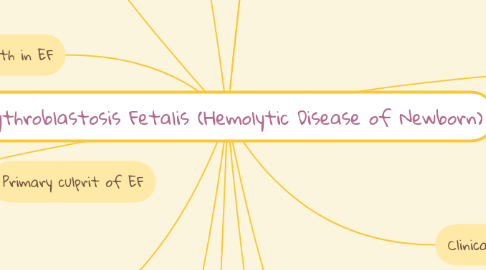
1. Effect of anti D antibody
1.1. Inhibits the production of antigen-induced B lymphocyte antibodies in expectant mother
1.2. These antibodies also attach to D antigen receptor sites on Rh+ve fetal Rbcs
1.2.1. That may cross the placenta
1.2.2. enter into circulation of expectant mother
1.2.3. interfere with mother's immune response to D antigen
2. Effect of mother's antibodies on fetus
2.1. Mother's anti-Rh antibodies diffuse slowly thorugh placental memb. into fetus's blood.
2.2. Cause agglutination of 's Rbcs
2.3. Agglutinated rbc hemolyze
2.4. Hb released into blood
2.5. Fetus's macrophages convert Hb into Bilirubin
2.6. Baby's skin turned yellow.
2.7. Jaundiced Baby
2.8. New Topic
2.8.1. Mother's antibodies may also attack other cells of body as well
3. Why called so?
3.1. Attempt of rapid production of rbcs
3.2. Early forms of rbcs(mainly nucleated blast forms) pass from baby's bone marrow into its ciculatory system
3.3. Presence of these nucleated blast forms in blood is the reason of the name of this disease.
4. Cause of baby's death in EF
4.1. Main cause=Severe Anemia
4.2. Secondary cause= Kernictrus(In case if that baby survived anemia which is a very rare case)
4.2.1. Precipitation of bilirubin in neuronal cells of brain
4.2.2. destruction of many neuronal cells
4.2.3. Baby gets permanent mental impairment/damage
4.2.4. This is kernictrus
5. Treatment
5.1. Replacement of neonate's Rh+ve blood with Rh-ve blood
5.2. About 400mL of Rh-ve blood infused(1.5 or more hours required to do so) while neonate's own Rh+ve blood is being removed
5.3. That process repeated several times during first few weeks of neonate's life
5.3.1. To keep bilirubin level low
5.3.2. To prevent kernictrus
5.4. by that time, Transfused Rh-ve cells are replaced by infant's own Rh+ve cells
5.4.1. 6 or more weeks required to do so
5.4.2. Cuz by that time, mother's agglutinins had been destroyed
6. Prevention of EF
6.1. Development of Rh immunoglobulin globin/anti D antibody
6.2. in 1970s
6.2.1. Anti D antibody administered to expectant mother at 28-30 weeks of gestation
6.2.2. reduction in incidence of EF occured
6.2.3. It is also administered to Rh-ve mother delivering Rh+ve babies
6.2.3.1. New Topic
6.2.3.1.1. Prevent sensitization of mothers to D antigens
6.2.4. This step reduces the risk of development of large amounts of D antibodies during 2nd pregnancy
7. Primary culprit of EF
7.1. D antigen
7.2. D antigen causes sensitization/immunization of Rh-ve mother to Rh+ve fetus
8. Mother's anti Rh agglutinins remain in baby's circulation for another 1-2 days after birth.
9. Mother Rh -ve Father Rh+ve Baby Rh+ve(inherited Rh+ve antigen from father)
10. Disease of fetus and newborn child, Agglutination and phagocytosis of fetus's Rbcs
11. Incidence of disease
11.1. Ist Rh+ve baby =No harm 3% of 2nd Rh+ve baby= some signs of EF 10% of 3rd Rh+ve baby= exhibit disease Incidence rises with subsequent pregnancies
12. Clinical picture of EF
12.1. Destruction of more n more Rbcs
12.2. Baby becomes anemic
12.3. Hepatospleenomegaly occurs
12.3.1. Liver and spleen enlarged
12.3.2. produce rbcs in the same manner as they produced in the middle(2nd) trimester of gestation
